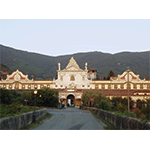Museo Nazionale della Certosa di Calci [National Museum of the Carthusian Monastery at Calci]
Although the foundation of the Certosa of Pisa dates from 1366, the elegant forms that we admire today derive mainly from subsequent stages of enlargement and remodelling, which took place especially starting from the third decade of the 17th century. Enhanced by sumptuous decorative schemes created in the 17th and 18th centuries by important artists, the Certosa of Pisa became one of the favourite places of the grand-ducal court. In the museum's itinerary, which traverses the fascinating interior of the Monastery, are objects of indubitable scientific interest, such as the antique pharmacy and the ingenious hydraulic system.
The pharmacy, founded in 1643 on the right side of the Monastery, was moved to the entrance lodge in 1703, to allow access to the people of the surrounding territory. In 1795 it was renovated with wooden furnishings, fabricated by the Pisan craftsman Pasquale Matteucci, and with ceiling decoration of ornamentation and allegorical figures, such as the Allegory of Medicine painted by Niccolò Matraini. From 1799 to 1875 it was managed by the Viola family; in 1906 it ceased to operate. The original furnishings were restored in 1931, as is indicated on a corner of the olive-wood shelves running along the walls in the sales area. For its elegant decoration scheme, the pharmacy constitutes an unicum of great value. Dating from the late 19th century are the ornamentation and inscriptions in the waiting room giving access to the sales area and the laboratory. The "Spezieria" displays a collection of jars for conserving medicinal substances, distillates and syrups produced by the monks.
Equally important, for the economy of the Monastery, must have been the hydraulic system, still partially functioning. Through a complex network of channels, it conveyed water used for various purposes (drinking water, irrigation, fish farming) into six basins and two fountains, while a brief section of the water main went to drive a mill. Rainwater was collected in two cisterns, for use in times of water shortage.
****************************
Texts by Graziano Magrini
English translation by Catherine Frost
Last update 23/feb/2008




